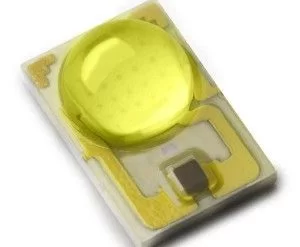Efficacy is the highest yet from Lumileds – over 200 lm/W at the top end of the highest bin – attributed by the company to lime being close to 555nm, the wavelength that human eye cones are most sensitive to. The data sheet specifies Lime as 567.5nm dominant wavelength (566-569nm). Lumileds green is 530nm (520-540nm).
There is a lot more information in this Lumileds Lime story on Electronics Weekly’s main site.
What is puzzling me is, what is the technology inside this LED.
Mining the data sheet is tricky because Lumileds specifies some die at 350mA, some at 700mA, some at 25°C, and some at 85°C.
From the curves, is shares characteristics with both direct and converted die, and the forward drop is lower than both blue and gree, while you would expect it to be between them if they are all GaN.
I have emailed Lumileds, and await a response.
Expect this blog to get longer as the data sheet reveals its secrets.
Is this a blue die with a phosphor, or a direct-emitting die? – deer stalker on.
*All die 1mm2 except ES and Lime which are 2mm2
** calculated from 2.72V at 350mA 85°C, and -2 to -4mV/K. All from data sheet
pc = phosphor converted – pc amber is a GaInN die with a phosphor
– interestingly, there is no trace of a blue bump in the spectrum above.
AlInGaP is used for the first four, and GaInN for the rest – probably .

